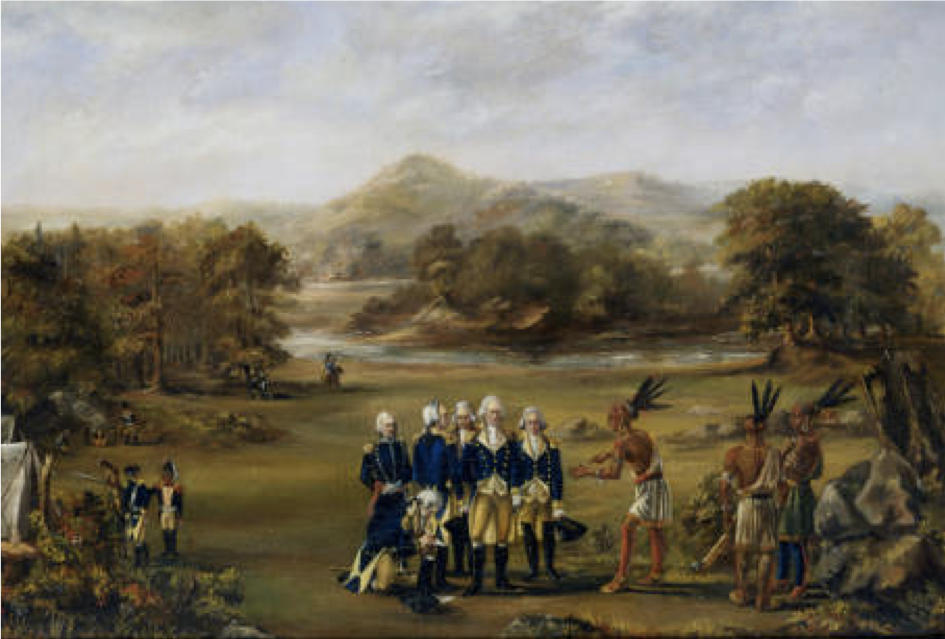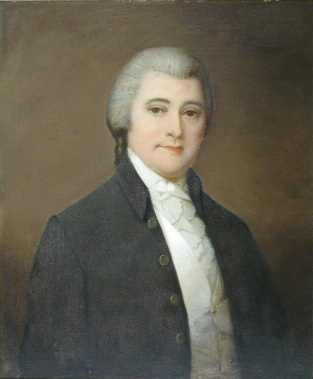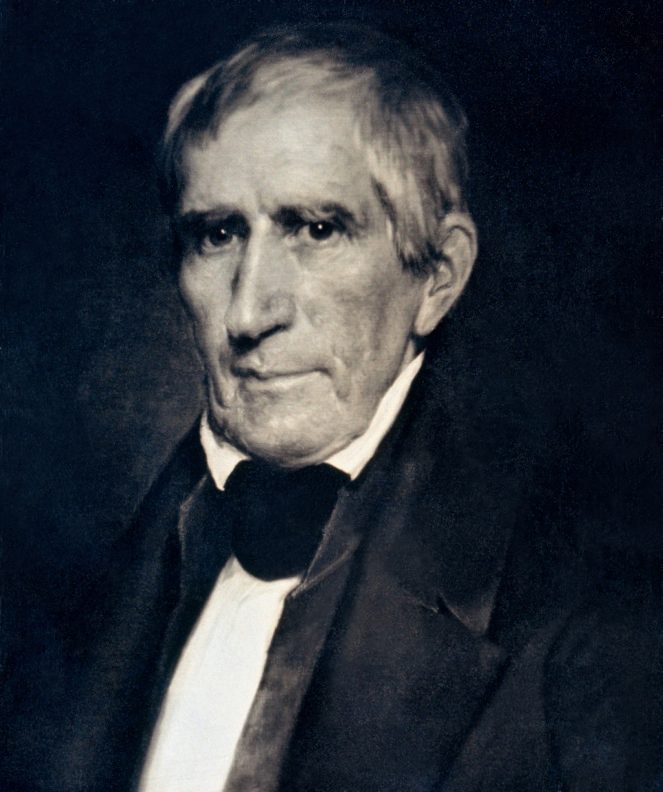Just before the Revolutionary War, the Transylvania Company purchased most of present-day Kentucky and part of Tennessee from the Cherokee nation, in the Treaty of Sycamore Shoals. While both the British government and the new state governments of North Carolina and Virginia refused to recognize the corporation’s land title, the colonialist powers argued that Indigenous rights had been extinguished. Twenty million acres were added to the colonialist property system. The acquisition kicked off a mania in large-scale land speculation that even the Revolutionary War could not restrain.

During the war, the cash-strapped US government promised land to soliders in lieu of pay. Army officers became the most avid of land speculators, and before the war was over, they created the Society of the Cincinnati to push for US land acquisition. The US quickly organized the Northwest Territory to administer its expansion into present-day Ohio, and members of the Society took over the territorial government.
Indigenous nations from the Muscogee in the South to the Miami Confederacy in the North successfully resisted US expansion for decades. As that resistance was slowly overcome, major land speculators – Robert Morris, Oliver Phelps, Daniel Constable, William Blount, James Wilkinson, organizers of the State of Franklin, the Lewis family and in-laws of Andrew Jackson among them – attended land cession treaties. Once Indigenous rights had been extinguished through those treaties, the speculators acquired millions of acres from the government, through purchase or large-scale fraud.
In the first few years of the 1800s, US claims of dominion expanded through the Louisiana Purchase. Before the War of 1812, the US was already negotiating treaties that extinguished aboriginal title west of the Mississippi.
The First Treaty
The United States signed its first official treaty with an Indigenous nation – the Lenape Delaware -- during the Revolutionary War. Ostensibly a military alliance, the treaty included a request from the US to send troops through Lenape territory in order to attack Detroit. Lenape leader Koquethagechton (White Eyes) offered to guide the troops. Behind the scenes, however, US interests in acquiring Indigenous land were already apparent. US signers included George Washington’s land agent William Crawford and the treaty commissioners, Thomas and Andrew Lewis. Soon after the treaty, the Lenape were protesting to Congress against encroachment on their land by militia members and settlers. Relations were moved to the breaking point by a quick succession of incidents: the attempted massacre of a Delaware delegation to Congress by white frontiersmen; the mysterious death of White Eyes while guiding the troops to Michigan; and the destruction of several Delaware villages by treaty signer and land speculator Daniel Brodhead’s troops. Within a year of the treaty, the Lenape were actively supporting the British.
"Northwest Indian War"
When the Revolution ended, member nations of the Iroquois Confederacy ceded land in Pennsylvania and New York. The Miami Confederacy, however, successfully resisted US expansion into Ohio. The federal government signed treaties with Miami allies, hoping to lay the groundwork for land sales and settlement, but continued hostilities rendered the treaties virtually meaningless. When the Northwest Territory was formed, former army officers – members of the Society of the Cincinnati -- created the Ohio Company and assumed control of the Territorial government. They also purchased millions of acres in Ohio from the federal government, but until treaties were negotiated, land sales could not be finalized. In trying to strong-arm Indigenous nations into ceding their land, the Territorial government negotiated several more abortive treaties, and mounted disastrous military campaigns against the Miami Confederacy, Harmar’s Defeat and St. Clair’s Defeat.
Hopewell
During the Revolution, the Continental Army and militia members conducted scorched-earth campaigns against Cherokee towns, some of which were officially neutral in the war. As the US gained a military advantage, state and local officials negotiated unofficial treaties that ended hostilities. Peace was officially recognized in federal treaties at Hopewell, the home and trading post of Andrew Pickens (who had fought against the Cherokee during the War). The treaties set limits on US expansion, and guaranteed the Cherokee, Chickasaw and Choctaw security within set boundaries. The boundary with the Cherokee, however, involved a large land cession in present-day Tennessee (including the site of Nashville). Colonialists were already squatting on Cherokee land within that nation's diminished borders.
Greenville, 1795
In 1791, Congress overcame its reluctance to create a permanent military force by establishing the Legion of the United States to defeat the Miami Confederacy. At the decisive Battle of Fallen Timbers in 1794, Anthony Wayne brought Miami military resistance to an end, and engineered an extensive land cession in Ohio the next year at Greenville. Military officers who were present at the battle and the treaty – notably James Wilkinson and
William Henry Harrison – rose to national prominence. Ten years after the treaty at Greenville, the boundaries of the cession were expanded to cover the Connecticut Western Reserve in Ohio, which already had been purchased conditionally by Oliver Phelps and his associates. The address made at the Treaty of Greenville, 1795, by Tarhe (the Crane, Wyandot leader), can be found at the Wyandot Nation website here.
|
Iroquois and New York
In the 1790s, treaties with member nations of the Iroquois Confederacy created reservations in New York, and extinguished land claims by Iroquois people who had moved to Canada. One of these treaties - an unauthorized treaty in 1798 with State of New York - was later recognized by the federal government. Among the Iroquois treaties, those with the Seneca in particular were tied to massive private land speculation ventures. Oliver Phelps and Nathaniel Gorham purchased 6,000,000 acres of New York from Massachusetts (following a complicated jurisdictional dispute). and paid the Seneca to extinguish their claim to 2,000,000 acres. Their agreement with the Seneca was recognized through a treaty in 1794, but Phelps and Gorham went broke before they could reach an agreement on their remaining claim. Robert Morris (the richest man in the US) purchased much of that land, as recognized in a 1797 treaty. Subsequent boundary changes were made in 1802.
Muskogees and Georgia, to 1805
The aggressiveness of Georgia speculators and settlers, and massive frauds by land speculation companies and Georgia state officials, led the federal government to assert its treaty making role in the Southeast through treaties with the Muscogee (Creek), beginning in 1790. These early Creek treaties illustrate the complicated political cross currents of that place and time. Andrew McGillivray, who led the Muscogee delegation in 1790, was a paid agent of Spain, a partner in a British trading company, and the son of a Scottish trader; at the treaty he was secretly made a general in the US army. James Wilkinson, a US commissioner for several of the treaties, was a general in the US army and secretly a paid agent for Spain. William McIntosh, who led the Muscogee delegation in 1805, was the son of a another Scottish trader, and became the brother-in-law of Benjamin Hawkins, one of the US treaty commissioners. The treaties in this era incrementally opened more land to white settlement, in Muscogee cessions of strips of land that moved their boundaries westward.
Cherokee and Tennessee, 1791-1806
 At the 1775 Treaty of Sycamore Shoals (mentioned above), a corporation called the Watauga Association claimed the northeastern corner of current-day Tennessee. In the administrative confusion at the end of the Revolution, Wataugans formed the autonomous State of Franklin. During its five-year history Franklin exacerbated hostilities with the Cherokee by forcing illegal land cession treaties. Franklinite leaders (e.g. Return Meigs, Daniel Smith, James Robertson) also speculated in land with the nefarious William Blount. Eventually North Carolina and the federal government asserted control of the area, nullified the Franklin treaties, and in 1790 organized the Southwest Territory (currently the State of Tennessee). But Blount successfully lobbied to become Territorial Governor, and placed Franklinites in government positions – making them even more powerful. For fifteen years, US-Indian diplomacy in Tennessee alternated among self-serving treaties forged by the Franklinites in their capacity of treaty commissioners, and federally-originated treaties that sought to mitigate the consequences. At the 1775 Treaty of Sycamore Shoals (mentioned above), a corporation called the Watauga Association claimed the northeastern corner of current-day Tennessee. In the administrative confusion at the end of the Revolution, Wataugans formed the autonomous State of Franklin. During its five-year history Franklin exacerbated hostilities with the Cherokee by forcing illegal land cession treaties. Franklinite leaders (e.g. Return Meigs, Daniel Smith, James Robertson) also speculated in land with the nefarious William Blount. Eventually North Carolina and the federal government asserted control of the area, nullified the Franklin treaties, and in 1790 organized the Southwest Territory (currently the State of Tennessee). But Blount successfully lobbied to become Territorial Governor, and placed Franklinites in government positions – making them even more powerful. For fifteen years, US-Indian diplomacy in Tennessee alternated among self-serving treaties forged by the Franklinites in their capacity of treaty commissioners, and federally-originated treaties that sought to mitigate the consequences.
Choctaw and Chickasaw, 1801-1805
At the end of the 1700’s, four corporations tried to buy most of current-day Mississippi from the State of Georgia, in the Yazoo Land Fraud. The federal government nullified the sale, frustrating the nation's largest land speculators. But speculators continued to focus their sights on an area stretching from the Yazoo River (near Natchez) east to Spanish-held Mobile. Between 1801 and 1805, the Choctaw and Chickasaw nations signed six treaties with the United States that ceded land in this region. In 1801 the US negotiated the right to build a road nearly 500 miles long, from Nashville to Natchez; the road followed the immeasurably old Indigenous route called the Natchez Trace. The Choctaw also ceded 2.5 million acres around Nashville that year. In five subsequent treaties the Choctaw, indebted by trade, made further cessions of nearly five million acres. Commissioners for the treaties included two notable land speculators; the Franklinite James Robertson, who founded Nashville at one end of the Natchez Trace; and James Wilkinson, who had become a spy for Spain to get a Spanish grant of the Yazoo lands at the other end of the road.
Old Northwest, 1800-1812
When
 Ohio became a State, the remainder of the Northwest Territory was renamed Indiana Territory. William Henry Harrison, famous from the Battle of Fallen Timbers, became the territory’s first governor. He relentlessly pushed for land cessions from Indigenous nations. Fur traders and townsite developers Indiana played a large role in negotiating these treaties. The result of this aggressive land acquisition was a mess of clouded and fraudulent land titles that led to decades of litigation. Eventually, Michigan Territory was carved from Harrison’s domain; its governor, William Hull, managed to negotiate a land cession around Detroit and the right to build a road into Ohio before surrendering the territory to the British when the War of 1812 began. Ohio became a State, the remainder of the Northwest Territory was renamed Indiana Territory. William Henry Harrison, famous from the Battle of Fallen Timbers, became the territory’s first governor. He relentlessly pushed for land cessions from Indigenous nations. Fur traders and townsite developers Indiana played a large role in negotiating these treaties. The result of this aggressive land acquisition was a mess of clouded and fraudulent land titles that led to decades of litigation. Eventually, Michigan Territory was carved from Harrison’s domain; its governor, William Hull, managed to negotiate a land cession around Detroit and the right to build a road into Ohio before surrendering the territory to the British when the War of 1812 began.
TREATIES SIGNED BY WILLIAM HENRY HARRISON:
TREATIES SIGNED BY WILLIAM HULL:
Trans-Mississippi, 1804-1808
For a brief period after the Louisiana Purchase was made, William Henry Harrison was the unelected governor not only of Indiana Territory, but of the Louisiana Territory as well. During his year in charge he engineered a Sauk and Fox cession of an enormous tract of land in Illinois, Wisconsin and Missouri, in a treaty so egregiously fraudulent that it led, years later, to the Black Hawk War. The first permanent governor west of the Mississippi was, surprisingly, James Wilkinson, the twice disgraced general and spy for Spain. He sent an underling, Zebulon Pike, north on the Mississippi to locate a site for a fort, resulting in a small land cession from the Dakota. The real power in the Louisiana Territory, however, was held by the fur trading Chouteau family. After Wilkinson was dismissed for his involvement in the Burr Conspiracy, Lewis and Clark in their new territorial government positions relied on the Chouteaus to effect another enormous cession, this time from the Osage: the southern two thirds of current-day Missouri and the northern third of Arkansas. |
